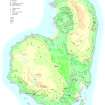Pricing Change
New pricing for orders of material from this site will come into place shortly. Charges for supply of digital images, digitisation on demand, prints and licensing will be altered.
Upcoming Maintenance
Please be advised that this website will undergo scheduled maintenance on the following dates:
Thursday, 9 January: 11:00 AM - 3:00 PM
Thursday, 23 January: 11:00 AM - 3:00 PM
Thursday, 30 January: 11:00 AM - 3:00 PM
During these times, some functionality such as image purchasing may be temporarily unavailable. We apologise for any inconvenience this may cause.
Field Visit
Date 15 May 2001
Event ID 1015558
Category Recording
Type Field Visit
Permalink http://canmore.org.uk/event/1015558
This township is situated on broken ground between the cliffs of Guala Thoinisteir and the coast to the W. The nucleus of the settlement, which comprises nineteen buildings, a corn drying kiln, a mound and at least seven small yards or enclosures, lies about 180m N of Howlin farmhouse (NM48NE 49), at the edge of an extensive system of irregular fields. It is bisected by a trackway that runs from N to S and also by a burn that drains S from Tobar Cuidh Capuill about 100m to the N (NM48NE 83). A second spring, Tobar Mhor Tholain, is situated at the S edge of the settlement (NM 47799 89727).
The buildings, which are all rectangular or sub-rectangular on plan are mostly distinguished by rounded external corners. They measure between 3m and 9.8m long and between 2.2m and 3.8m transversely, usually within stone or boulder-faced turf walls (sometimes incorporating edge-set stones) up to 1.5m thick and 0.9m high. Three have been almost entirely removed as a result of stone robbing (316-18), while the mound may also represent a collapsed structure (321). Faint indications of a midden are visible immediately NW of one building (301) and a byre-drain is associated with another (302). However, one of the more poorly preserved structures is exceptional in measuring 16.5m from NE to SW by 3.2m transversely within a grass-grown rubble-faced wall 1.3m thick and 0.4m high (312). A corn drying kiln is situated about 10m to its SSW. Its kiln bowl, which is partly choked with rubble, measures 0.8m in diameter and at least 0.9m deep.
Clear indications of phasing are rare, but a smaller building has been built over the central portion of the exceptionally long structure and there is at least one other instance where one appears to overlie another (300-301). Two roofless buildings associated with a roughly trapezoidal enclosure immediately S of a modern roofed shed are also relatively late in date (659-60).
Most of the enclosures are attached to a building, although the largest stands alone to the E of the track (304). It is roughly oval on plan and measures 26.8m from NNE to SSW by 12.8m transversely, within a stone-faced wall 1m thick.
Some of the fields contain traces of rig cultivation. Their wide variation in size and shape suggests a piecemeal process of expansion and enclosure. Such field systems are common on the W coast of Scotland - notable examples having been recorded at Achiltibuie (RCAHMS 1997) and on Waternish, Skye (RCAHMS 1993). They have probably survived here because they lie outwith the Cleadale crofting settlement, which was established to the south in 1809. The Five Pennies township and its fields are shown in some detail on Bald's map (1806) and an outline of its history is provided in recent summaries of the island's story (Wade-Martins 2004, Dressler 1998). Three of the buildings are shown roofed (300, 659-660) and five unroofed (303, 305?, 308, 310, 312) on the 1st edition of the OS 6-inch map (Inverness-shire (Skye) Sheet LXXI, 1879).
(EIGG01-97, 300-21, 659-660, 755)
Visited by RCAHMS (SDB) 15 May 2001







